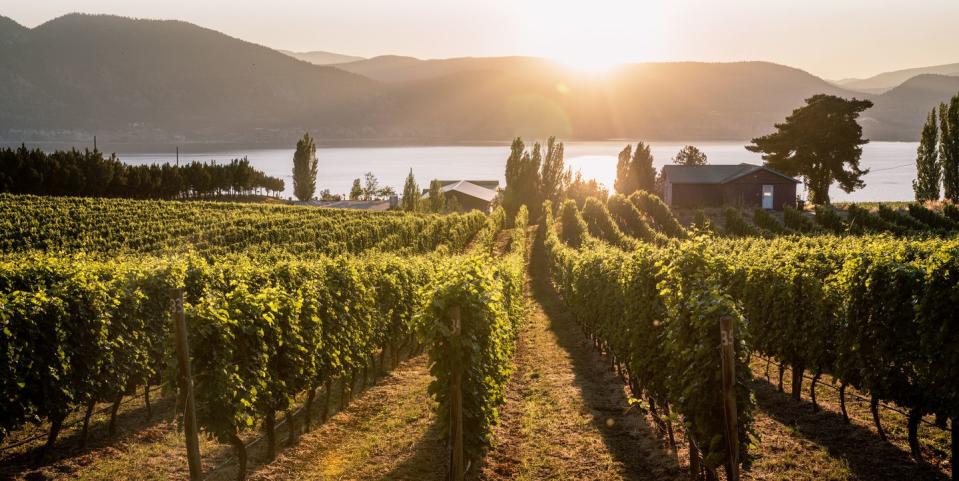Wine Country: Is Canada the New Napa?

Jaws dropped in certain quarters of Manhattan, not to mention France, when Doug Barzelay announced that he was buying a vineyard in British Columbia. Barzelay, 72, is one of the world’s leading experts in the wines of France’s Côte d’Or and co-author of the definitive Burgundy Vintages: A History from 1845. He has been known to drink Bordeaux, if it’s old enough, and occasionally certain wines from the Northern Rhône and the Piedmont. But no one who knows him would dream of bringing a New World wine to dinner, which is why his purchase of a vineyard in the Okanagan Valley was news.
I flew to BC recently to visit the scene of what many see as the unlikeliest conversion since Saint Paul. The initial revelation took place in 2011 in Vancouver, where Barzelay stopped on his way to a wine auction in Hong Kong. “My friend Rob Caine organized a dinner with a lot of really great Burgundies and one wine blind,” Barzelay says. “The closest I could come in identifying it was Chambolle-Musigny. He pulled the wrapper off, and it was this wine I had never heard of from a region I had barely heard of. ”
A 2006 Foxtrot pinot noir from the Okanagan Valley, to be exact. This experience was in the back of his mind until after election day 2016, when “I decided I didn’t want to have all my assets tied up in the U.S.”
That winter Barzelay and his business partner, Nathan Todd, toured the Okanagan from top to bottom, discovering that Foxtrot wasn’t the only winery making good wines. The valley is located almost a hundred miles north of the border; it surrounds Okanagan Lake, a narrow, fjordlike body that tempers the climate along its shores. The area has long been the fruit basket of western Canada, producing apples and cherries as well as grapes, thanks to the many hours of summer sunshine and rich deposits of glacial sediment.

Barzelay made a discovery on that first trip that excited him and ultimately linked his new enthusiasm to his passion for old Burgundy: Many of the existing vineyards, including Foxtrot, are planted with ungrafted vines. In the middle of the 19th century, phylloxera, a tiny louse native to eastern North America, made its way to Europe on imported grape vines and devastated the vineyards of France. The European Vitis vinifera vines had no resistance to the pest.
The vineyards were eventually restored by grafting European vines onto the roots of American vines, which had developed an immunity to phylloxera. To this day, most of the world’s Vitis vinifera vines are grafted onto American rootstock. But there are those who claim that the wines made from Vitis vinifera planted on their own roots have a texture and depth that is unique.
Doug Barzelay is one of those people and one of the few living individuals who have tasted many wines made from pre-phylloxera grapes. “Having spent time pondering whether pre-phylloxera Burgundies were really different, and why,” he says, “all of a sudden I thought, ‘Oh my god, here’s a place where you can still grow pinot noir without the mediation of the rootstock.’”

In 2017 he and Todd bought five unplanted acres on the Naramata Bench, adjacent to Foxtrot. Just a few months later the Allander family, owners of Foxtrot, privately announced that they wanted to sell, and once Barzelay and Todd took possession of Foxtrot’s six acres, the oldest of which are planted with 25-year-old ungrafted vines, they decided to plant the new vineyard with half grafted and half ungrafted vines—an experiment that will be fascinating to follow as they make two different cuvées from the two sections.

Sitting in the small house above the no-frills cement cellar where the wines are made, I tasted recent vintages back to 2010, and I was impressed. These are serious, complex, and ageworthy pinots. On the basis of this and other wines I tasted from the area—including several excellent chardonnays and pinot noirs from Meyer Family Vineyards, it’s clear to me that the Okanagan is more than promising. I was reminded of visiting Oregon’s Willamette Valley 25 years ago.
At the opposite end of the spectrum from the bare-bones Foxtrot operation is Phantom Creek, the ambitious venture of Chinese businessman Richter Bai, who is spending an estimated $100 million to create a 50,000-case operation specializing in cabernet and syrah, set to open to the public this year. In different ways, the arrival of a Chinese billionaire and an American wine expert suggest a bright future for this provincial region—although Doug Barzelay says he has no immediate plans to change his Burgundy-centric drinking habits.
This story appears in the February 2020 issue of Town & Country.
SUBSCRIBE NOW
You Might Also Like

